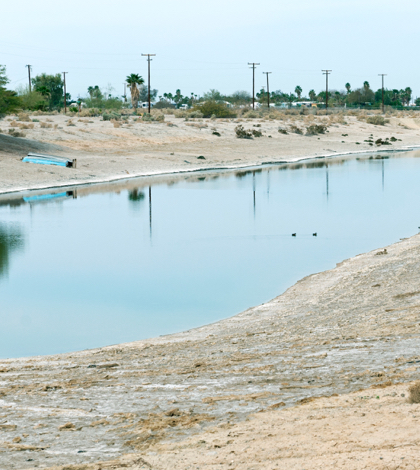After years of negotiations, petitions and delays by participating agencies, the State Water Resources Control Board approved a landmark agreement on Tuesday for the management and restoration of the Imperial Valley’s Salton Sea. The plan outlines actions over the next decade for the shrinking lakebed as well as efforts to protect public health and the century-old Pacific flyway habitat. The plan formalizes state officials’ commitments for the next 10 years.
The plan calls for covering up less than half of the more than 60,000 acres of dry lakebed; the current strategy is also far less elaborate than the $8.9-billion proposal released in 2007 by state officials. But participating agencies are hailing the new agreement as a “smaller but sustainable” Salton Sea.
“Restoration of a smaller but sustainable Salton Sea is critical to protecting air quality for Imperial and Coachella Valley residents and maintaining valuable wildlife habitat,” said California Secretary for Environmental Protection Matthew Rodriquez. “This consensus agreement shows the way forward, while the State Water Board’s oversight provides the transparency and accountability to ensure we meet its goals.”
The shrinking Salton Sea is often a blowing dust bowl contributing to various respiratory ailments of the region’s residents. According to the California Department of Public Health department, Imperial County’s reported 2014 emergency room visits by children ages 5 to 17 was 162.9 versus the state for California’s 72.4 as per the age-adjusted rate per 10,000 residents; this translate into Imperial County having the highest number of asthma-related emergency room visits for children in the state.
Additionally, the lake has no outlet and is saltier than the ocean. It regularly gives off odors resembling rotten eggs. These conditions are already threatening to kill off the lake’s remaining fish and drive away birds that have sought the lake on their migratory path for more than a century.
In order to help mitigate these issues, the 10-year plan calls for construction of 29,800 acres of ponds, wetlands and dust-suppression projects on portions of exposed lakebed. The plan outlines annual targets for completion, beginning with 500 acres in 2018 and ramping up to 4,200 acres in 2028. The agreement further commits the state to creating a long-term plan beyond the initial 10 years.
The approval of the new Salton Sea Management Plan by the State Water Board outlines the board’s oversight role in monitoring and ensuring progress toward the plan’s goals and sets annual milestones for dust-suppression projects and habitat restoration over the next 10 years. The agreement was reached through discussions among a broad group of stakeholders led by the California Natural Resources Agency.
“Successful management of a smaller but sustainable Salton Sea requires active support and participation from local, state and federal governing bodies, and stakeholders,” said State Water Board Chair Felicia Marcus. “The annual milestones give us a roadmap to pick up the pace, and the annual public meeting will maintain transparency and keep a light shining on this hugely important effort and on all of us.”
However, full funding for the $383 million plan has yet to be secured. The state of California has committed more than $80 million in voter-approved bond funds to restore habitat and suppress dust at the lake in the near term. A $14 million grant from the state Wildlife Conservation Board will help in funding habitat conservation at the Salton Sea, and the Salton Sea Authority will administer a $7.5 million U.S. Department of Agriculture grant for water conservation, wetland creation, and air quality mitigation.
Additionally, as part of SB 5 by Senator Kevin de Leon (D-24th District-Los Angeles) a bond measure will go before voters on the June 2018 statewide ballot that, if approved, would provide an additional $200 million for Salton Sea projects.
While the new agreement is a major step forward for local and state agencies – and the Salton Sea-area residents – much work and funding are still needed.
In the words of Kevin Kelley, general manager of the Imperial Irrigation District, “Foremost in our mind(s) is that there needs to be a pathway forward. It’s a 10-year road map.”
 California Water News Daily Your Source For Water News in California
California Water News Daily Your Source For Water News in California


